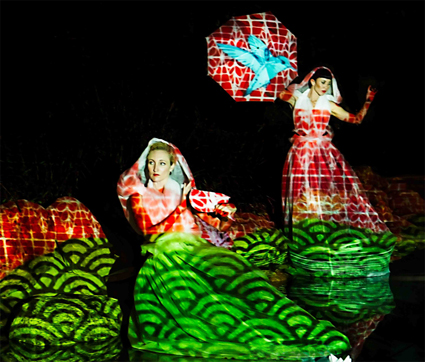Not so strange strangers
Nicola Fearn: Polytoxic, Trade Winds

Leah Shelton & Lisa Fa’alafi, Tradewinds, Polytoxic
courtesy the artist
Leah Shelton & Lisa Fa’alafi, Tradewinds, Polytoxic
Two women, dressed in identical voluminous white dresses, appear in the water at each side of the Darwin Recreation Lagoon—they float towards each other carrying small origami boats. Their easeful passage is disrupted as the women stumble, their boats dipping dangerously, the gentle ethereal music becomes dissonant and their glide momentarily jagged.
The dangers of sea travel is referenced, resonating with a northern Australian audience used to asylum seekers being turned away from their shores. The women meet but cannot work out how to greet, each performing ritual gestures that do not match.
Polytoxics’ performative outdoor installation Trade Winds depicts the meeting of women from different cultures. A dance work with contemporary pop aesthetic projections from Samuel Tupou, it is set to a rhythmic soundtrack of piano, electronica and bass hums. The women look identical, they wear matching dresses, carry the same umbrellas and mirror each other’s movements as vibrant projected patterns cover them. Is it deliberate that these supposedly different cultures appear to be mirror images of each other or is the audience watching from the beach the stranger? The narrative is loose in Trade Winds with the visual element as the main focus.
The women’s dresses and umbrellas form screens for the animated projections of the weird, wonderful and sometimes bizarre creatures and plant life they encounter in a strange land. The pair are in turns intrigued, amused and afraid of these highly coloured creations that run riot over their clothing—blue pigs, purple crocodiles, insects, hummingbirds, rapidly growing flowers and slightly oddly, what appeared to be a rainstorm of decapitated heads. Much of the dancers’ movement is restricted to ritualised arm and hand gestures and occasional exaggerated pantomime as they respond to the creatures, patterns and plants.
Following their meeting, both with each other and an alien culture, the women drift back to their sides of the lagoon and eventually out of sight—seemingly unchanged by their brief encounter.
For a visual work the overwhelming problem was the necessity for front-on viewing vital if one was to see the projections which were the mainstay of the piece. The audience sat in a semi-circle around the lagoon but only those sitting directly in front of the performers were able to see the animations.
The workshop prior to the event engaged the largely family audience with children making origami boats which carried their written dreams and hopes. These were internally lit and floated on the lagoon during the performance. This ‘message-in-a-bottle’ reaching out across the waters was powerful and poignant for a Darwin audience that is itself a cultural melting pot and only a few hours sail away from our Asian neighbours.






